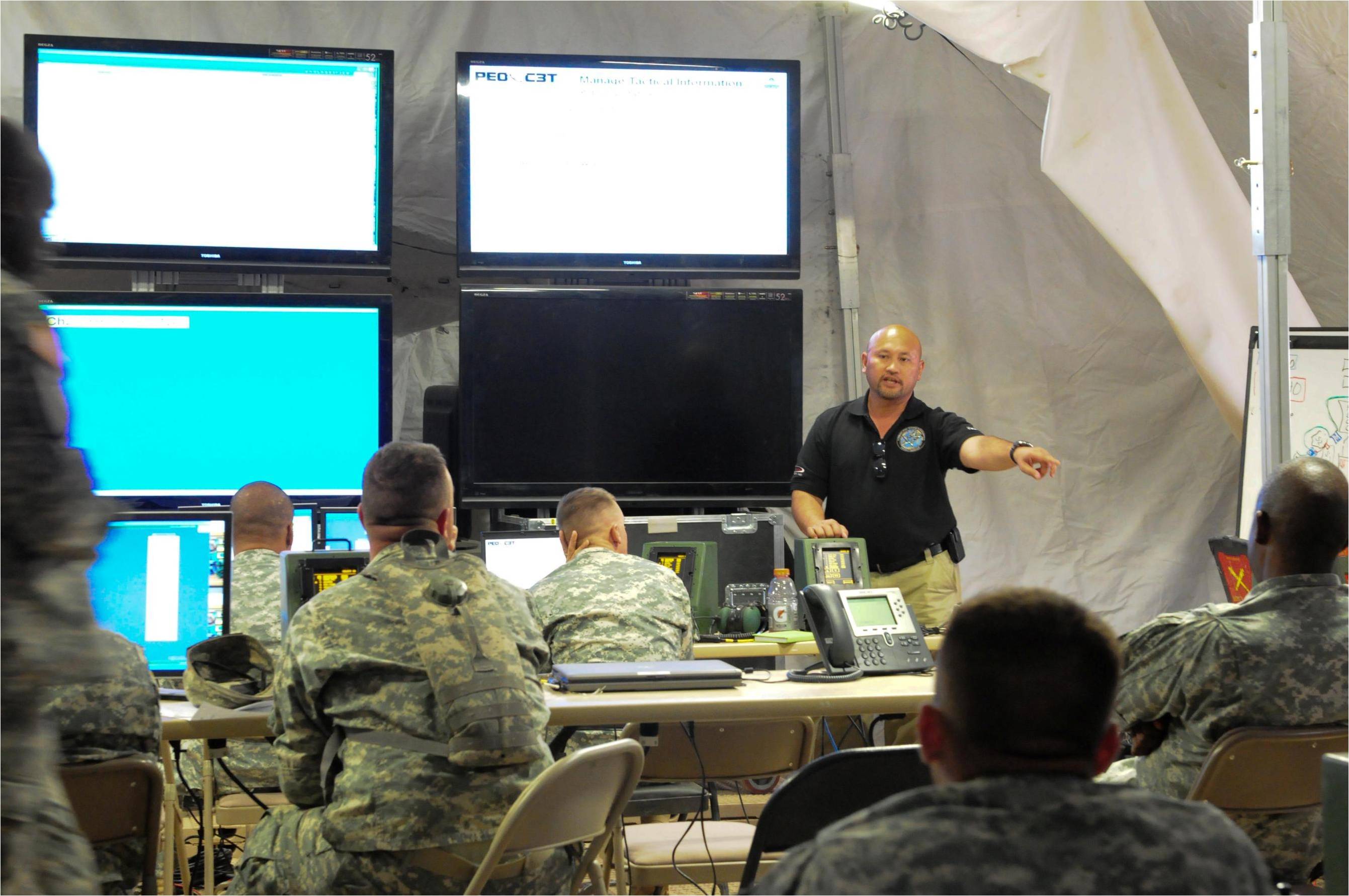
As preparations for the Army’s Network Integration Evaluation (NIE) kick into high gear, Soldiers, engineers, combat developers, and test officials are joining forces at Fort Bliss, TX, and White Sands Missile Range (WSMR), NM, to provide full-time support to what will be the Army’s largest, most robust network test and evaluation effort to date.
The 3,800-plus Soldiers from the 2nd Brigade Combat Team, 1st Armored Division (2/1 AD) who are executing the six-week test and evaluation make up the first full brigade the Army has used in its test and evaluation process. The unit has spent the past several months preparing for the NIE in both field training and classroom exercises.
“The brigade has been preparing for the June/July exercises almost nonstop,” said MAJ Rick Galeano, Information Operations, 2/1 AD. “We have Soldiers taking part in a variety of network and non-network program training events, which are very important to ensure that we have well-trained and prepared Soldiers for the evaluations. In addition to classroom instruction, all battalions have conducted intensive numerous field and live-fire exercises.”
[raw][image align=”left” caption=”During a Battle Command System-of-Systems Integration Training exercise at Fort Bliss, 2/1 AD Soldiers established both brigade- and battalion-level networked CPs and participated in intensive CP integration exercises inside the tactical operations center. (U.S. Army photo.).” linkto=”/web/wp-content/uploads/DSC_1629.jpg” linktype=”image”]”/web/wp-content/uploads/DSC_1629_compressed.jpg” height=”167″width=”246″[/image][/raw]In March, 2/1 AD Soldiers participated in Battle Command System-of-Systems Integration training at Fort Bliss to instruct the unit in the use of all current Command Post (CP) equipment in a battle command environment. During the 12-day training exercise, Soldiers established both brigade- and battalion-level networked CPs and participated in intensive CP integration exercises.
“The goal is to build the infrastructure and architecture of a fully operational tactical operations center—14 large ‘tents’ filled with the unit’s own equipment,” said Galeano. “This not only ensures that the unit has the right level of connectivity to deliver mission command information to the brigade prior to going out into the field, but also determines how emerging network capabilities at both lower and higher tactical levels will integrate into the command post and then communicate with each other.”
Establishing a baseline of current capabilities at the brigade and battalion levels allowed the unit to better assess how new capabilities at the platoon and company levels integrate with current and/or theater-provided systems during follow-on communication exercises in May. In addition, the exercise provides an opportunity for the brigade to carry out various tasks including validating CP infrastructure and network, managing tactical information, learning restoration capability in case of network malfunction, and creating a common operational picture.
Classroom Training
Many brigade Soldiers are also enrolled in daily classroom training to learn how to integrate and operate a broad array of capabilities, including the Joint Tactical Radio System Ground Mobile Radio, remote weapon delivery systems, and products provided in Connecting Soldiers to Digital Applications, an Army initiative aimed at developing and evaluating hand-held applications and capabilities.
Soldiers attend the classes at brigade headquarters, where six new classrooms can accommodate up to 40 Soldiers in each. Others attend equipment training on acres of sprawling motor pool lots filled with the latest Army combat and tactical vehicles including Strykers and fully outfitted Mine Resistant Ambush Protected All Terrain Vehicles.
‘A Thorough Operational Workout’
Throughout April, 2/1 AD Soldiers conducted Force XXI Battle Command Brigade-and-Below (FBCB2) Joint Capabilities Release training. The training, held by Project Manager FBCB2 within Program Executive Office (PEO) Command, Control, and Communications-Tactical, prepared 2/1 AD Soldiers to operate the new system effectively when they field-test the equipment at WSMR this summer.
[raw][image align=”right” caption=”Soldiers from 2/1 AD attend equipment training on acres of sprawling motor pool lots filled with the latest Army combat and tactical vehicles, including Strykers and fully outfitted Mine Resistant Ambush Protected All Terrain Vehicles. (U.S. Army photo.) ” linkto=”/web/wp-content/uploads/DSC_1608_compressed_2.jpg” linktype=”image”]”/web/wp-content/uploads/DSC_1608_compressed_2.jpg” height=”167″width=”246″[/image][/raw]In June, the entire brigade, with a cadre of test officials, will occupy WSMR for the start of the test and evaluations.
“By integrating systems across the 2nd Brigade, 1st Armored Division, we will ensure these capabilities get a thorough operational workout,” said COL John Wendel, Deputy Program Executive Officer for Networks, PEO Integration. “When the Army fields network capabilities, not all Soldiers receive them at the same time. Part of our challenge during these upcoming rehearsal and evaluation events is to figure out how to make sure units who have the new capabilities can talk to units that don’t have all the new capabilities. It’s all about proper capability integration and real-world, Soldier-driven, operationally relevant evaluations—that’s what this entire community is working to solve.”
The June/July NIE is the first of four major test and evaluation events aimed at synchronizing multiple programs and evaluating technologies to determine how well they fit into a larger, integrated tactical network. The culminating event in late 2012 will help slate the content for the first Capability Set to be fielded to deploying brigades in 2013-14. A Capability Set is a total package of networked and non-networked hardware and software fielded to a particular unit.
[list type=”arrow”]
- KATIE CAIN supports media relations and strategic communications activities on PEO Integration’s public affairs team. She holds a B.A.A. in integrative public relations, with a concentration in political science, from Central Michigan University.







